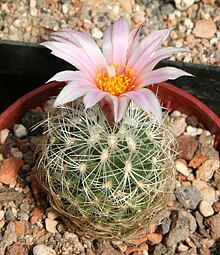Turbinicarpus
This article includes a list of references, related reading or external links, but its sources remain unclear because it lacks inline citations. (September 2012) |
| Turbinicarpus | |
|---|---|

| |
| Turbinicarpus knuthianus | |
| Scientific classification | |
| Kingdom: | Plantae |
| Clade: | Tracheophytes |
| Clade: | Angiosperms |
| Clade: | Eudicots |
| Order: | Caryophyllales |
| Family: | Cactaceae |
| Subfamily: | Cactoideae |
| Tribe: | Cacteae |
| Genus: | Turbinicarpus (Backeb.) Buxb. & Backeb. |
| Type species | |
| Turbinicarpus schmiedickeanus | |
Turbinicarpus is a genus of very small to medium-sized cacti, which inhabit the north-eastern regions of Mexico, in particular the states of San Luis Potosí, Guanajuato, Nuevo León, Querétaro, Hidalgo, Coahuila, Tamaulipas and Zacatecas.
Ecology[]

These succulent plants grow mostly on limestone soil (never on volcanic soil), at altitudes between 300 and 3300 metres above sea level.
Turbinicarpus species are usually confined to specific habitats, generally hostile for the majority of plants, mostly in very drained rocky areas, composed of limestone, sandstone, schist (neutral or alkaline), or in very acidic and humiferous understorey, or in gypsum veins, sometimes so pure that they are almost white.
In particular, Turbinicarpus sensu stricto is adapted to extreme niches: more than 80% of the species grow in rock cracks or among the pebbles beneath them, where enough dust has accumulated to enable root development. It would seem almost impossible that plants so small could survive in such an environment, however in those species that inhabit dry and exposed areas, the root is very thick, becoming a taproot and acting like an anchor on the slopes but, more important, as water storage for the dry periods, capable of significantly retracting into the ground so that the stem is less exposed to the sun; the spines are often changed to adopt a very papery structure, capable of absorbing good quantities of water. Furthermore, the general look is extremely mimetic, thanks to the epidermis colour and the interlacing spines, guaranteeing a certain protection from eventual herbivores.
Taxonomy[]
The taxonomic history of the genus Turbinicarpus is rather complex and often mixed with that of other genera like Echinocactus, Echinomastus, Gymnocactus, Mammillaria, Neolloydia, Normanbokea, Pediocactus, Pelecyphora, Strombocactus, Thelocactus and Toumeya, as the results of almost two centuries of constant evolution in the understanding of the affinities and relationships inside the family Cactaceae. Many points of view about the classification of Turbinicarpus are available currently. A genus revision by Davide Donati in 2003, and again in 2004 with Carlo Zanovello, was based on:
- carpology
- chorology
- DNA analysis
- ecology
- flower characteristics
- intercrossing test, to test the concept of biological species
- morphology
- ontogeny of the entire body and above all of the spination
- seed characteristics.
At the end of that study, Rapicactus was considered a distinct genus from Turbinicarpus. The genus Turbinicarpus was subdivided in two subgenera at the light of the results of the DNA analysis, and in many series because of the ontogeny of the spination.
Species list[]
Genus Turbinicarpus[]
Subgenus Turbinicarpus[]
Serie Gracilis[]
Serie Lophophoroides[]
- Turbinicarpus alonsoi
- Turbinicarpus bonatzii
- Turbinicarpus knuthianus
- Turbinicarpus jauernigii
- Turbinicarpus laui
- Turbinicarpus lophophoroides
- Turbinicarpus rioverdensis
Serie Macrochele[]
- Turbinicarpus macrochele subsp. frailensis
- Turbinicarpus macrochele subsp. polaskii
- Turbinicarpus macrochele subsp. valteri
Serie Turbinicarpus[]
- Turbinicarpus klinkerianus subsp. schwarzii
- Turbinicarpus klinkerianus subsp. hiemalis
- Turbinicarpus klinkerianus subsp. planiziei
- Turbinicarpus schmiedickeanus
- Turbinicarpus schmiedickeanus subsp. rubriflorus
- Turbinicarpus schmiedickeanus subsp. andersonii
Serie Valdeziani[]
Serie Gymnocactus[]
- Turbinicarpus saueri subsp. saueri
- Turbinicarpus saueri subsp. nelissae
- Turbinicarpus ysabelae
Serie Viereckii[]
- Turbinicarpus gielsdorfianus
- Turbinicarpus viereckii subsp. viereckii
- Turbinicarpus viereckii subsp. neglectus
natural hybrids[]
- Turbinicarpus × mombergeri (pseudopectinatus × laui)
Subgenus Kadenicarpus[]
Section Bravocactus[]
Section Kadenicarpus[]
- Turbinicarpus krainzianus subsp. minimus
- Turbinicarpus pseudomacrochele
Other species[]
Synonymy[]
The following genera haven been brought into synonymy with Turbinicarpus:
- Gymnocactus Backeb.
- Normanbokea Kladiwa & Buxb.
References[]
- Davide Donati & , Knowing, understanding, growing Turbinicarpus-Rapicactus (Ed. Cactus Trentino SudTirol, 2005) pp. 254
- Edward F. Anderson, The Cactus Family (Timber Press, 2001), pp. 665–673
- Grupo San Luis, The Genus Turbinicarpus in San Luis Potosì (Ed. Cactus&Co, 2004)
External links[]
- Turbinicarpus
- Medicinal plants
- Cactoideae genera